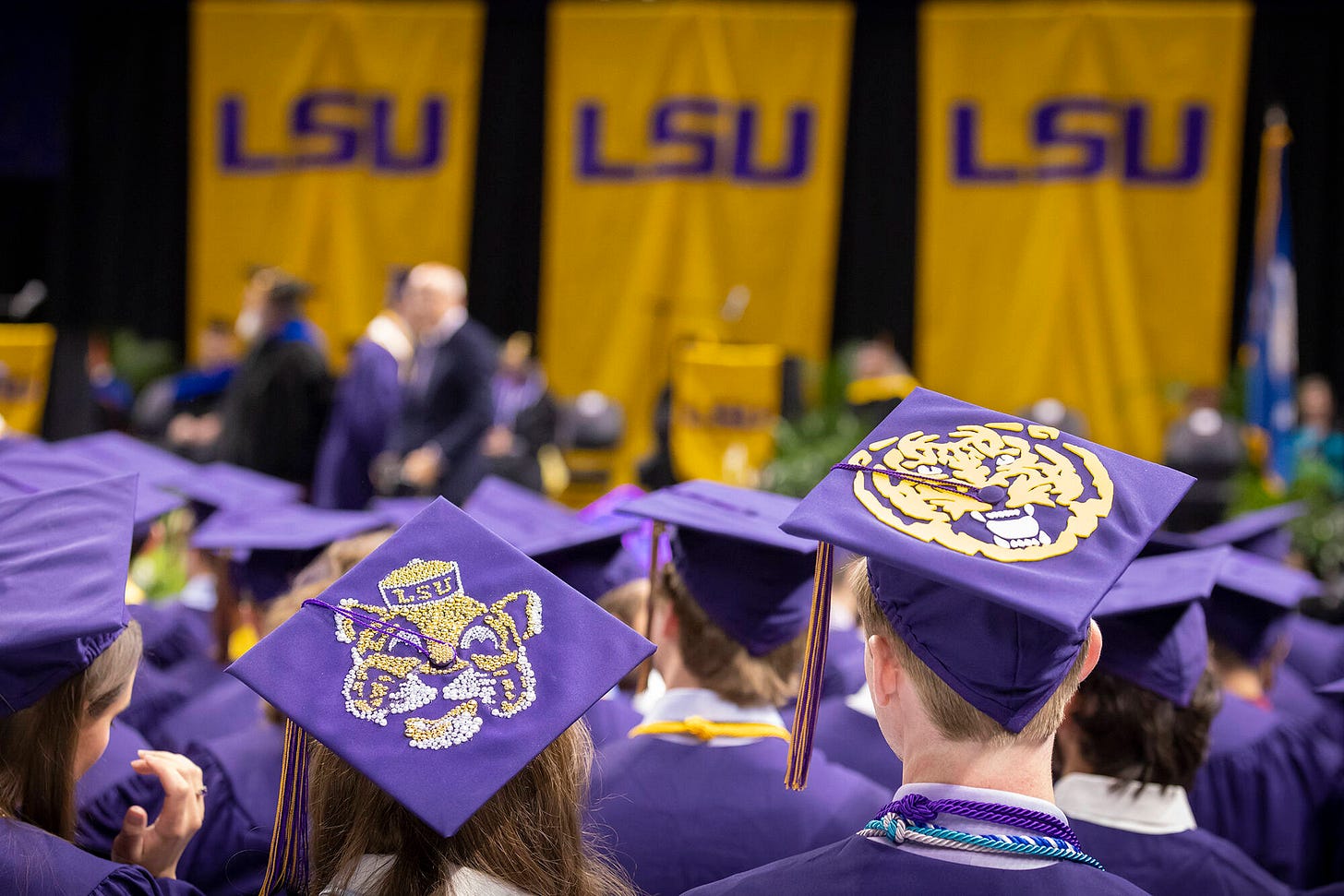Why did Livvy Dunne major in Interdisciplinary Studies?
And why did Paul Skenes major in it too?
One of the biggest stories these days in baseball is Paul Skenes. Last Friday, in his second major league game, he struck out eleven of the nineteen batters he faced. Over the last two years, he’s become one of the most famous young baseball players out there. But to many people, he’s known first and foremost as Livvy Dunne’s boyfriend.
Dunne is a recent graduate of LSU, the same institution that Skenes attended. While there as a member of the gymnastics team, she became the highest-earning female NIL athlete, getting more endorsement dollars than even Caitlin Clark. She’s leveraged millions of social media followers to become one of the faces of college sports.
I’ve watched Skenes’ first two starts because he was a highly touted prospect, but I didn’t know much about Dunne. When you look up any of her gymnastics highlights, you will see that she is listed as an Interdisciplinary Studies major.
Since I’m the kind of person who writes a blog about college curricula for fun, I felt compelled to dig. The two words that compose the major’s name are so vague they feel almost meaningless. It’s a major in “learning about different stuff”? How much structure is imposed by it? How individualized is it? And what might make a student choose this academic track?
What isn’t Interdisciplinary Studies?
At one level, the answer to my initial question is easy to find. While I didn’t delve into the depths of social media, I was able to skim the surface and find a statement about Dunne’s academic plan in an interview she did for Sports Illustrated. In it, we learn two things:
She began college as a communication studies major.
She changed her major to interdisciplinary studies because she did not want to take Spanish anymore.
My first assumption was that in making this move, Dunne was switching between colleges.
Louisiana State, like most American universities, is structured as a federation of associated colleges sharing a single campus. LSU has over a dozen separate institutions under its aegis, each with its own undergraduate and/or graduate programs. So while there is a single administration, the day-to-day governance of the colleges of business, music, science, etc. are wholly separate.
Most universities have a set of general education requirements, courses that are mandatory for every undergraduate student. But individual colleges within that university may require additional general education for students in their programs.
If you look at LSU’s general education requirements, you’ll see that while students can fulfill their 9 required humanities credits through studying a foreign language, they have other options like history or philosophy or public speaking which can satisfy that requirement. Otherwise, there is no universal foreign language requirement.
But if you pursue a communication studies BA, as Dunne did, you’ll be in the College of Humanities and Social Sciences. And those students are beholden to additional general education requirements, including four semesters of foreign language.
So that means Livvy Dunne must have switched out of the College of Humanities and Social Sciences to avoid that language requirement, right?
The importance of an acronym
Well, my assumption was incorrect. Interdisciplinary Studies is also part of the College of Humanities and Social Sciences. So what’s going on? Let’s look more closely at that foreign language requirement one more time:
“Foreign Language–A minimum of 14-16 credits (four semesters) in a foreign language for the BA or BS degrees.”
If you look at the listing for Interdisciplinary Studies, you’ll see the degree is actually neither a BA nor a BS. It’s a BIS: a bachelor’s of interdisciplinary studies. So this is not just the name of the major, it’s also the nature of the degree.
If you look through the majors offered in the College of Humanities and Social Sciences, you’ll see that every major except interdisciplinary studies is a BA or BS. So the wording of the language requirement effectively functions as a way to exempt exactly one program.
New phone, who BIS?
The construction of the interdisciplinary studies major is unusual. There are four different tracks students can select, broad fields like health science or leadership.
Aside from a couple required courses and a capstone, students in this major are really completing three minors. For example, although I did not see this listed, it’s likely that Dunne completed the “Studies in Organizations” track. This program requires students to complete minors in business, sociology, and communication studies.
If she had already begun a communication studies degree, that would put her on a path to switch to this track easily. Additionally, she said that she is taking business courses in marketing, which would align with a second minor in this track.
So the BIS is a major composed of three minors. Although it’s labeled as “interdisciplinary,” students will not see these disciplines intersect in a purposeful way. Instead, they are three separate paths students pursue simultaneously. Each course remains separated into its own disciplinary bubble.
The single culminating capstone course is intended to align the three minors, but it’s likely asking too much of a single class to unify four years of siloed coursework. Perhaps a more accurate name for this major would be “Tridisciplinary Studies.”
BIS is me… now
If we look at the LSU graduation reports from 2023, we can learn a few more things about how this program works. 127 students earned the BIS. This amounts to 12% of graduates from the College of Humanities and Social Sciences and less than 2% of LSU graduates in that academic year. So while the degree is flexible, it does not seem particularly sought after.
Additionally, students graduating with a BIS held an average GPA of about 2.7. Compare this with an average GPA of 3.3 for the rest of the College.
My suspicion is that this program exists primarily to receive students who are struggling with other programs and provide them a path to graduation. In Livvy Dunne’s case, she was struggling with Spanish and wanted to avoid taking it again. For other students, they may have struggled in business or biology or any number of other subjects. But if they completed enough courses in their original major to achieve a minor, then they could avoid harder upper level courses and do additional minors instead.
You can see another clue for the BIS as a second-chance degree by looking at credits earned. The average BIS graduate earned 22 more credits than their peers in the rest of the College. I’d guess this is due to those students having partially completed programs in other fields but not being able to apply all of their existing credits to the BIS.
This “extra credit” pattern is likely true for most students graduating with “second” majors. But the reason you see a uniquely high average credit total for the BIS is that it’s almost exclusively a “receiving” major that students transfer into, instead of an initial major, for its graduates. Thus, you see the kind of credit totals typical of students switching their majors because there are few students beginning with a BIS major.
A brief note on “receiving” majors
Universities are heavily incentivized to improve their graduation rates. It’s one of the most common statistics that prospective students use, rightly or wrongly, to assess whether they are a “good school.”
Universities will provide academic off-ramps like the BIS to prevent students who might otherwise drop out from doing so. My own doctoral program at Indiana University recently did something similar, creating the Ed.S. in Higher Education as a way for students who have completed their doctoral coursework, but not their dissertation, to still receive a degree (i.e. to still “graduate”). Since almost every student in my program enters already holding an MA in higher education, they needed something above a master’s degree but below a doctoral degree to make sure the program could maintain its graduation rate.
When dropping out is not an option.
Now, Livvy Dunne was not likely to drop out regardless. Her brand was built on being a college athlete. But the BIS did provide a path of less resistance, maintaining her student-athlete identity while also presenting a lighter academic burden overall.
Dunne became a millionaire before she was legally allowed to purchase alcohol. Her boyfriend, Paul Skenes, knew that he was about to become a millionaire once he got drafted by a professional baseball team. For both of them, the academic program was a necessary burden, but one that should be minimized. They didn’t need LSU as an educational institution per se; they needed it as a base to pursue their long-term goals in social media and sports. So it makes sense that both of them would follow this track.
Final considerations
When I was thinking about the BIS, it reminded me of the beginnings of the elective system in American higher education. Around the turn of the 20th century, Harvard led the way in changing how students enrolled in class. Instead of a uniform classical diploma with a set sequence of courses, students could “elect” any course they chose to take in any discipline.
In this transitional moment, the system of “majors” was not fully nailed down. While there was an overall credit requirement for graduation, students could choose to avoid a “set” program and design one of their own without needing it to be approved by anyone else.
The effect was that students “designed” their course of study to include as many introductory courses as possible, putting together schedules that included as many “easy A’s” as they could. While administrators imagined that students would fall in love with a discipline and freely pursue it, the effect was different. Many students really wanted to spend four years at college, but graduation was the point, not studying. Since course work was no more than a necessary obstacle, students found a way to make that obstacle as small as possible.
The “major” system as we recognize it today is essentially a compromise. Universities agree not to impose the kind of absolute curricular control that they did before the twentieth century; students agree to complete courses with a modicum of rigor in a given field, while still maintaining the liberty to combine classes and programs with broad latitude.
The BIS appears to be about as close as higher education is willing to get toward reverting to a pure elective system. These students have lots of curricular freedom, but not total freedom. They can take more introductory courses than other programs, but not only introductory courses. They are denied the prestige of the BA/BS degrees, but if graduation is the point, does that even matter? Does anyone notice?
I am curious about how common it is for institutions to offer a BIS-style degree. Does the presence or absence of the BIS say anything about how universities perceive their own prestige? Do arts and humanities faculties resist it? Would that resistance be due to its prestige perception or due to fears of its siphoning off discipline-aligned students? And how different does the student population for BIS degrees look from students pursuing individualized majors?
As always, I conclude with more questions. But hey, at least they’re new questions!
-Matt








